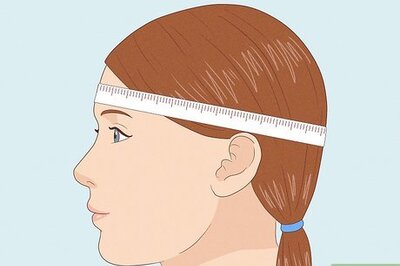
views
Control board glitch.
Reset the washer. You might be seeing the error due to a simple glitch and nothing is actually wrong. Resetting your washer will clear out the glitch: Unplug the washer from power and wait 5 minutes before plugging it back in. If you still see the 4C or 4E code when you turn the washer back on, you may need to do more troubleshooting.
Clogged detergent dispenser.
Clean the detergent dispenser. Using more than the recommended amount (there's an indicator inside the lid), or a non-HE detergent can lead to clogging, which leads to either water overflow or a weak water flow. Any of these outcomes can produce a 4C/4E code. Clear out the clogged dispenser to get rid of the code without having to buy a new part. Start with the washer off and unplugged from power. Remove the detergent dispenser drawer. You'll find a lever inside the drawer that lets you remove it easily. Take apart the drawer. There are two components: the softener compartment and the detergent section. Use warm water to clean the parts. Use a tool like a tooth brush to clean nooks and crannys that you can't reach inside the washer. Put all the pieces back together once they are clean and dry, then slide the drawer back into the washing machine. Set the washer to a "Rinse" cycle without laundry in it to complete the process.
Low water pressure.
Check that you have sufficient water pressure. Anything lower than the 20-120 psi range and your washer will display 4C or 4E. Here's how you can test your water pressure: Pull the washer away from the wall to access the main water supply valve. Use a towel or something to catch any water that drips. Disconnect the valve from the hose. Attach a pressure gauge to the valve and open it completely. Make sure that the reading on the gage is in the 20-120 range. If the weather is colder and there are uninsulated pipes in your house, note that you might be dealing with a frozen or burst pipe. Contact a plumber immediately to deal with any frozen or burst pipes and that might get rid of your 4C/4E code on the washer. You can also call your utility company to see what your water pressure is.
Water tap not fully opened.
Open the valve completely. If the tap isn't completely open, you'll experience some water pressure issues. Follow these steps to find and open your tap fully: Unplug your washer from power and pull it away from the wall. Turn the water tap counterclockwise as far as it will go. Reconnect the washer to power and see if the code is gone.
Kinked or blocked water supply hoses.
Clean and straighten out the inlet hoses. A clogged or kinked hose that draws water from the supply valve into your washer will restrict the flow of water enough to trigger the 4C or 4E code. Here's how to clean the hoses: Turn off the washer and unplug it from power. Turn off the water supply valves for cold and hot water. Pull out the washer from the wall. Make sure the hoses aren't bent, pinched, or kinked. Place a towel or rag on the floor to catch water that leaks while you clean the hoses. Remove the mounting hardware that keeps the hoses at the back of the washer. Disconnect the hoses from the water supply valves. Look through the hose to find any obstructions. Use tools like high-pressure water or a long brush to dislodge obstructions. Reconnect the hoses to the valves and your washer and turn the water back on. Use this time to check for any leaks. Plug the washer back into power and check if the 4C/4E code is gone by running a short cycle.
Clogged mesh filters.
Clean the mesh filters. If the mesh filters are clogged, water flow is restricted and can cause the 4C/4E code. Clean these twice a year to keep the filters in good shape for longer. Turn off the water supply to the washer. Use towels or a bucket to catch water that spills during this process. Disconnect the water hoses from the back of the washer. Look inside the valves to find the mesh filters. Remove the mesh filters using a small tool, like needle-nose pliers. Clean the filter with warm water or a toothbrush. If the filter looks damaged or excessively worn down, buy a new one that fits your Samsung washer. Once clean, replace the filters in the valves and reconnect the hoses to the back of the washer. Turn the water supply back on and run a short cycle to see if the 4C/4E code is gone.
Faulty water inlet valve.
Replace the water inlet valve. This piece regulates the flow of water into the machine; when your washer needs water for a cycle, the control board sends an electrical signal to the inlet valve. If the valve is broken, it won't be able to control the flow of water, resulting in a 4C/4E code. Follow these steps to replace the water inlet valve. Unplug the washer from power and turn off the water supply. Pull the washer away from the wall so you can work behind it. Line the floor with towels to absorb any water that spills. Disconnect hoses from the back of your washer. Unscrew the screws securing the rear panel of the washer to reveal the inlet valves. Unplug the wire connectors secured to the faulty water inlet valve. Remove screws holding the faulty water inlet valve. Carefully remove the faulty water inlet valve. Place the new water inlet valve in the same place, then replace screws, and reconnect wires. Replace the rear panel on the washer and screw in any remaining screws. Reattach the hoses to the back of your washer and run a short cycle to see if the 4C/4E code is gone.



















Comments
0 comment